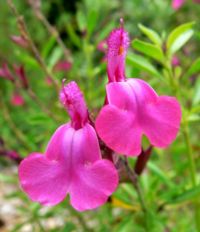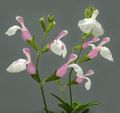Salvia greggii: Difference between revisions
No edit summary |
No edit summary |
||
| (3 intermediate revisions by 2 users not shown) | |||
| Line 1: | Line 1: | ||
{{ | {{SPlantbox | ||
| | |familia=Lamiaceae | ||
| | |genus=Salvia | ||
| | |species=greggii | ||
| | |common_name=Autumn sage | ||
| | |habit=shrub | ||
| | |habit_ref=Flora - A Gardener's Encyclopedia | ||
| | |Min ht box=12 | ||
| | |Min ht metric=in | ||
| | |Max ht box=36 | ||
| | |Max ht metric=in | ||
| | |height_ref=Flora - A Gardener's Encyclopedia | ||
| | |Min wd box=12 | ||
| | |Min wd metric=in | ||
|Max wd box=36 | |||
|Max wd metric=in | |||
|width_ref=Flora - A Gardener's Encyclopedia | |||
|lifespan=perennial | |||
|life_ref=Flora - A Gardener's Encyclopedia | |||
|exposure=sun | |||
|sun_ref=Flora - A Gardener's Encyclopedia | |||
|features=flowers | |||
|flower_season=early summer, mid summer, late summer, early fall, mid fall, late fall | |||
|flower_ref=Flora - A Gardener's Encyclopedia | |||
|flowers=blue, purple, white | |||
|Temp Metric=°F | |||
|min_zone=9 | |||
|usda_ref=Flora - A Gardener's Encyclopedia | |||
|max_zone=11 | |||
|image=Salvia greggii Coronado Pink 2.jpg | |||
|image_width=200 | |||
}} | }} | ||
'''''Salvia greggii''''' ('''Autumn sage''') is a herbaceous perennial native to a long, narrow area from southwest Texas, through the [[Chihuahuan Desert]] and into the Mexican state of [[San Luis Potosi]], typically growing in rocky soils at elevations from 5,000-9,000 feet. It was named and described in 1870 by botanist [[Asa Gray]] after J. Gregg, a Mexican trader who found and collected the plant in Texas. It is closely related to and frequently hybridizes with [[Salvia microphylla]]. Contrary to its common name, it blooms throughout the summer and autumn.<ref name="Clebsch">{{cite book|last=Clebsch|first=Betsy|coauthors=Carol D. Barner|title=The New Book of Salvias|publisher=Timber Press|date=2003|page=136|isbn=9780881925609|url=http://books.google.com/books?id=NM0iwB8GrQYC&pg=PA136}}</ref> | |||
''Salvia greggii'' is a highly variable plant, with numerous named cultivars, reaching anywhere from 1–4 feet in height and less in width. It can be either upright or mounding. The leaves are typically mid-green and glabrous, tending to be less than 1 inch long. Flower size and color are extremely variable. Flowers reach from .25-1 inch in length, and include many shades of scarlet and red (most common in the wild), along with rose, white, pink, lavender, apricot, and violet. The plant is used widely in horticulture.<ref name="Clebsch"/> | |||
Popular named cultivars include 'Furman's Red', a cultivar from Texas that blooms profusely in autumn with dark red flowers. Big Pink has a large lower lip with a deep pink color and lavender tint. 'Purple Pastel' is a small variety that repeat blooms in autumn. 'Cherry Chief 'blooms reliably in the humid southern United States. 'Desert Pastel' has pale apricot flowers with yellow streaks, and prefers mild climates.<ref name="Clebsch"/> | |||
{{Inc| | |||
== | Salvia greggii, Gray. Shrub, 1-3 ft. high: sts. glabrous or obscurely farinaceous; the branches slender: lvs. coriaceous, 1-ribbed, almost veinless, oblong, entire, base narrowed to a short petiole: racemes 2-3 in. long, 6-8- fld.; calyx narrowly campanulate, slightly pubescent or glandular; corolla red or purplish red, about 1 in. long, the tube strongly ventricose-gibbous, the throat abruptly contracted, the lower lip large and showy. Autumn. Texas and Mex. Var. alba, Hort., is a white-fld. form.{{SCH}} | ||
}} | |||
==Cultivation== | |||
===Propagation=== | |||
===Pests and diseases=== | |||
==Varieties== | |||
==Gallery== | |||
<gallery perrow=5> | |||
File:Salvia greggii Coronado Pink 1.jpg | |||
File:Salvia greggii.jpg | |||
File:Autumn Sage 'Teresa' (Salvia greggii).jpg | |||
Image:Upload.png| photo 1 | |||
</gallery> | |||
* | ==References== | ||
<references/> | |||
<!--- xxxxx *Flora: The Gardener's Bible, by Sean Hogan. Global Book Publishing, 2003. ISBN 0881925381 --> | |||
<!--- xxxxx *American Horticultural Society: A-Z Encyclopedia of Garden Plants, by Christopher Brickell, Judith D. Zuk. 1996. ISBN 0789419432 --> | |||
<!--- xxxxx *Sunset National Garden Book. Sunset Books, Inc., 1997. ISBN 0376038608 --> | |||
==External links== | |||
*{{wplink}} | |||
{{ | {{stub}} | ||
__NOTOC__ | |||
Latest revision as of 19:39, 10 May 2010
| Salvia greggii subsp. var. | Autumn sage | |||||||||||||||||||||||||||||||||||||||||||||||||||||||
|---|---|---|---|---|---|---|---|---|---|---|---|---|---|---|---|---|---|---|---|---|---|---|---|---|---|---|---|---|---|---|---|---|---|---|---|---|---|---|---|---|---|---|---|---|---|---|---|---|---|---|---|---|---|---|---|---|

|
|
| ||||||||||||||||||||||||||||||||||||||||||||||||||||||
| ||||||||||||||||||||||||||||||||||||||||||||||||||||||||
Salvia greggii (Autumn sage) is a herbaceous perennial native to a long, narrow area from southwest Texas, through the Chihuahuan Desert and into the Mexican state of San Luis Potosi, typically growing in rocky soils at elevations from 5,000-9,000 feet. It was named and described in 1870 by botanist Asa Gray after J. Gregg, a Mexican trader who found and collected the plant in Texas. It is closely related to and frequently hybridizes with Salvia microphylla. Contrary to its common name, it blooms throughout the summer and autumn.[1]
Salvia greggii is a highly variable plant, with numerous named cultivars, reaching anywhere from 1–4 feet in height and less in width. It can be either upright or mounding. The leaves are typically mid-green and glabrous, tending to be less than 1 inch long. Flower size and color are extremely variable. Flowers reach from .25-1 inch in length, and include many shades of scarlet and red (most common in the wild), along with rose, white, pink, lavender, apricot, and violet. The plant is used widely in horticulture.[1]
Popular named cultivars include 'Furman's Red', a cultivar from Texas that blooms profusely in autumn with dark red flowers. Big Pink has a large lower lip with a deep pink color and lavender tint. 'Purple Pastel' is a small variety that repeat blooms in autumn. 'Cherry Chief 'blooms reliably in the humid southern United States. 'Desert Pastel' has pale apricot flowers with yellow streaks, and prefers mild climates.[1]
| Standard Cyclopedia of Horticulture |
|---|
|
Salvia greggii, Gray. Shrub, 1-3 ft. high: sts. glabrous or obscurely farinaceous; the branches slender: lvs. coriaceous, 1-ribbed, almost veinless, oblong, entire, base narrowed to a short petiole: racemes 2-3 in. long, 6-8- fld.; calyx narrowly campanulate, slightly pubescent or glandular; corolla red or purplish red, about 1 in. long, the tube strongly ventricose-gibbous, the throat abruptly contracted, the lower lip large and showy. Autumn. Texas and Mex. Var. alba, Hort., is a white-fld. form.CH
|
Cultivation
Propagation
Pests and diseases
Varieties
Gallery
-
photo 1
References
- ↑ 1.0 1.1 1.2 Clebsch, Betsy; Carol D. Barner (2003). The New Book of Salvias. Timber Press. p. 136. ISBN 9780881925609. http://books.google.com/books?id=NM0iwB8GrQYC&pg=PA136.
External links
- w:Salvia greggii. Some of the material on this page may be from Wikipedia, under the Creative Commons license.
- Salvia greggii QR Code (Size 50, 100, 200, 500)



